Implement In-App Referral Programs for Your Mobile App

Your app has finally launched. You’ve got lots of users who are active and using your app on a regular basis. This is great news.
But if your download rates are starting to plateau or even possibly taper off, you’ll need to come up with creative strategies to get your app in the hands of new users.
There are lots of ways that you can approach this. But one of my favorite ways to get new downloads is by getting your current users to recommend your app to other people.
Why would anyone do something like this? You’ve got to give them a reason to. Implementing an in-app referral program is the way to make this happen.
For those of you who aren’t that familiar with this concept or need some help getting steered in the right direction, you’re in luck.
As an industry expert, I’ve got plenty of experience with in-app referrals. I’ll show you how to implement a mobile app referral program that actually works.
Here’s everything you need to know before you get started.
Keep user acquisition costs low
Any time you start a new marketing campaign, the cost is always the first thing that should come to your mind. You’ll want to make sure that you budget accordingly so that you don’t run out of money.
How much does it cost you right now to get a new user or customer? If this number gets out of control, your business could be in serious trouble.
You need to come up with inexpensive acquisition strategies.
That’s one of the best parts of an in-app referral program. It’s not going to cost you much money at all, which makes it one of my favorite mobile app marketing promotions.
Here’s a look at the average cost per app install from different countries.
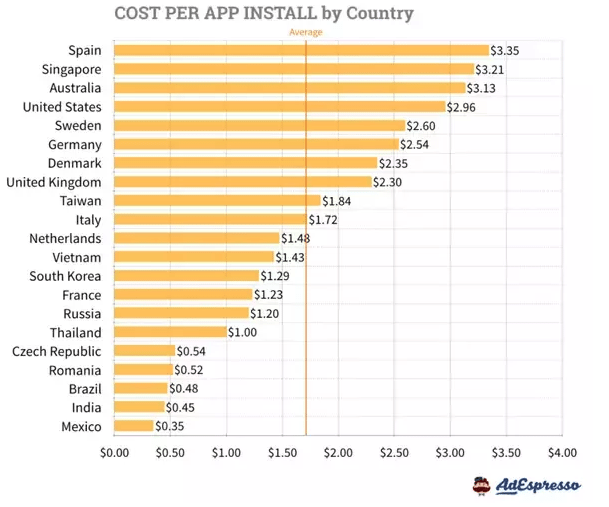
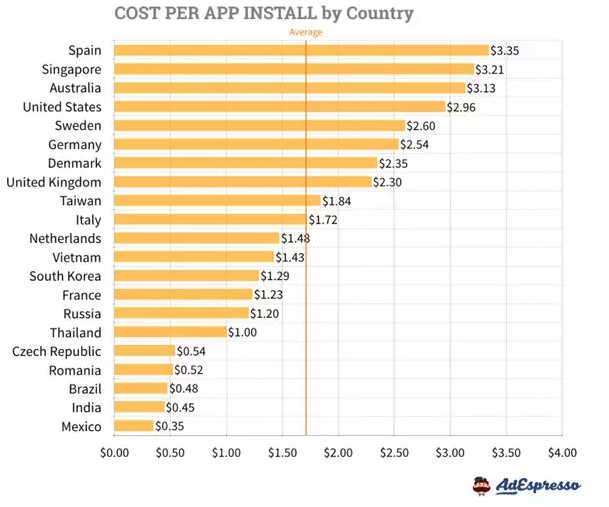
In every business, acquisition costs are everything. You can use this as a reference to see where your app stacks up.
The reason why user acquisition costs will be so low a referral is because you don’t need to promote it to new people. That’s the beauty of it.
You’ve just got to inform your current users about the program and let them to all of the work. This won’t cost you anything because you can already contact them via email, push notifications, or whenever they open up your app.
It’s not the same as launching a new and expensive marketing campaign where you have to collect new information from prospective customers. You don’t need new email subscribers.
Now it’s just a matter of knowing when to contact your current app users and how to pitch the program to them. I’ll cover all of this in much greater detail as we continue.
Get a high ROI fast
Another benefit of an in-app referral program is that you’ll get a high return on your investment. This has a lot to do with the fact that your acquisition costs are so low because these two numbers always go hand in hand.
But it should be pretty easy for you to make your money back fast.
The only major cost of your in-app referral program is whatever you’re offering to your current users and new users.
To explain what I mean in greater detail, I’m going to talk about a recent case study. This study focuses on Uber’s ride-sharing app, which I’m sure you’re familiar with.
Here’s how their program works. When a current user refers a new one, they each get a $20 credit toward a ride. So their user acquisition cost is $40. This number may seem high, but stay with me for a minute here.
Take a look at how much their average customer spends each month.


With the average user spending $95 per month and Uber keeping 25% of that, they’ll break even on their initial new download cost in less than two months.
Now they can benefit from these new users continuing to spend for the duration of that customer’s lifecycle with the company. So even if your initial investment sounds high, you can get a return on it fast with a strategy like this.
I always like to follow the lead of those who succeeded before me. Uber’s referral program is definitely a model that you can follow. Their success speaks for itself.
Offer an incentive for referrals
You may get the occasional user that refers your app to someone out of the kindness of their hearts. However, that’s not a viable or long term strategy for scalable growth.
You need to give people a reason to refer others. Make it worth their while. Look back at the case study that we just discussed. $20 is definitely something that people can get excited about.
For the most part, monetary benefits are the best. You should have a section of your app that’s dedicated to your referral program. Here’s a great example of what this looks like from the Airbnb mobile app.

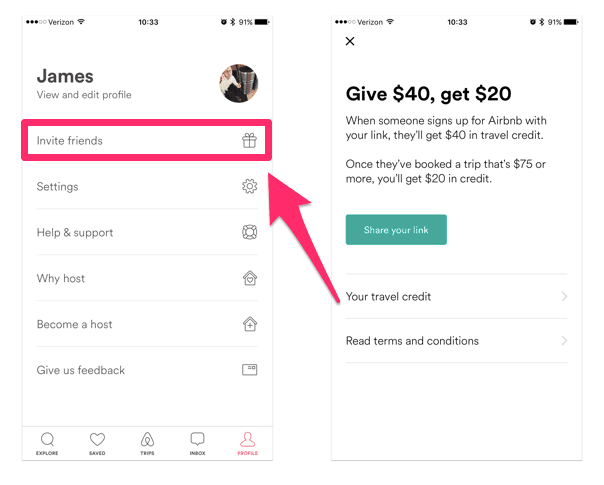
Users shouldn’t have to go through a complicated process to refer others. They should easily be able to send the link via text or email to their friends and family.
Another way to do implement this strategy is with a referral code. You can randomize a unique set of letters and numbers for each user, and then they can share that with their friends. Or even better, they can customize their own referral code so it’s easy to remember.
But again, they’re only going to do this if you offer a legitimate incentive. So for the Airbnb example above, the new user gets $40 and the current user gets $20.
A current user could easily get $100 in credits by referring five people. That may even be worth a free night or two somewhere, depending on the location.
If money isn’t exchanged on your app, you’ll need to come up with another incentive to encourage downloads. For example, if you’ve got a game app, you could offer free coins to help improve the gameplay experience to users who refer their friends.
Timing is everything
So you just launched your app. Time to release your referral program, right? Not so fast.
You don’t need to have a referral program as soon as you build your app. But you don’t want to wait too long either. Here’s why.
If the referral program is available too soon then people who download your app aren’t engaged and loyal customers yet. They don’t have a reason to refer anyone yet because they don’t even know if they want to continue using your app.
But waiting too long could be a problem too. Over time, people might start using your app less and less. So you’ve got to design your user lifecycle funnel to create loyal, engaged, and active customers.
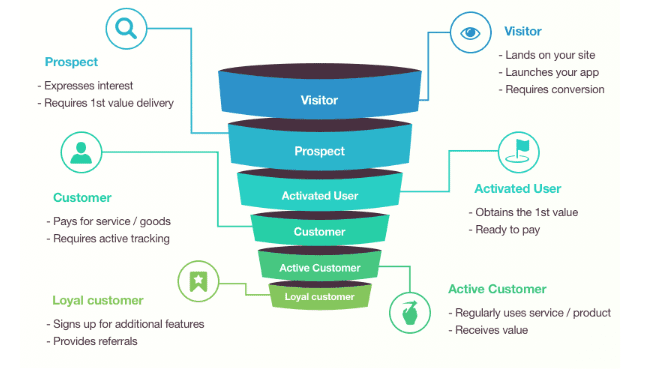

So keep an eye on your app analytics. Find the sweet spot for when you have lots of downloads and plenty of daily active users who are engaged.
This is the best time to launch your referral program. This will maximize the growth of your program as well as the success of your app and brand.
Use push notifications to remind users about the program
Once your referral program is set up and live, you’ve got to tell people about it. One of the best ways to do this is through push notifications.
Just don’t be pushy about it (pun intended).
Try sending a push notification once or maybe twice per user to tell them about your program. Then that’s it. Sending too many push notifications is annoying.
If they don’t take the bait right away, just leave it alone and you can try to reach them again with other methods, which we’ll discuss shortly.
Push notifications are great because they have such high conversion rates. Here’s a look at push notification engagement from different industries.
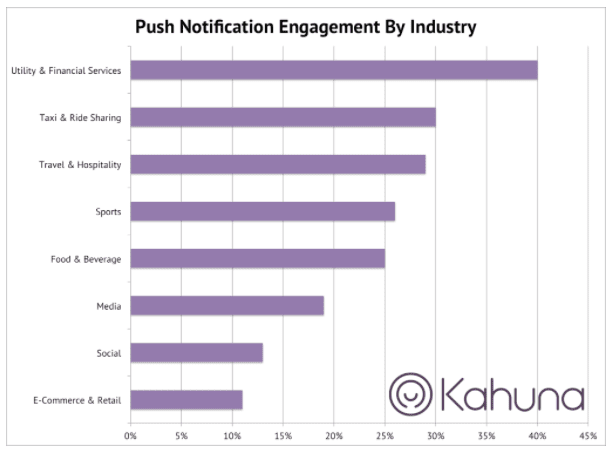

I know that I said you shouldn’t send too many push notifications. However, I’ve got a scenario where you can send multiple push notifications to the same user about your referral program.
Send out a notification whenever a referral is accepted. So for example, just sending out the referral probably won’t be enough to get rewarded. But once the new user buys something or completes a specific action, the original user can be notified.
So you could send a push notification saying something along the lines of, “A $10 credit was just added to your account for a new referral.”
These are messages that people want to receive because they’re being notified that they just got a reward. Now this user will be enticed to keep inviting more people since they know that their referral was validated.
Leverage all of your distribution channels
In addition to using push notifications, you’ll want to come up with other ways to spread the word about your in-app referral program. Promote it like crazy.
Since some users may not even get your messages if they have push notifications turned off on their devices, you’ll need to reach your active users through other channels.
Advertise the program on your website. You also need to share it on your social media profiles.
Get in contact with social influencers to promote the referral program as well. Use every distribution channel that you have. You can even use YouTube to promote it, if your YouTube channel is active.
Don’t forget about email marketing either. When people download your app, you probably had them create a profile before they could get started.
So take advantage of that database and contact your email subscribers. Email is great because users could forward the referral message directly to other people on their contact list.
More than half of emails are opened from mobile devices.


So if a prospective user gets an email forwarded to them about the program, there is a good chance that they’ll see it on their mobile device.
This will make it very easy for them to download and use your app if there is a download link that sends them directly to the app store.
Quality control
Make sure that your program is running smoothly.
The last thing you want to happen is for someone to refer people and not get rewarded. This is a bad look for your company and will definitely turn people away from using your app.
You also need to make sure that the new customers are rewarded as well. Thoroughly test your app to make sure that it works on all different devices as well as reference methods.
For example, if people can refer friends via text and email, you need to make sure that both options work.
You also need to keep an eye out for anyone who might be taking advantage of you or the program. There will always be people out there that want to find loopholes in the system.
They may try to create multiple accounts on your mobile app from different devices. Or maybe they’re setting up several email addresses and entering different credit cards to make it appear like you’re getting new users.
But in reality, it could just be one person with five accounts who keeps referring themselves and getting free stuff out of it. If this happens too often, it can crush your acquisition costs and kill your ROI, which we discussed earlier.
So try to come up with a quality control system with safety nets in place to prevent things like this from happening.
Make adjustments
Referral programs work if your existing users are having a great experience with your app.
If your app has issues, nobody will refer their friends. So make sure you’re constantly updating the app and make sure that it’s performing at a high level.
Now users will be more likely to participate in the program and refer their friends.


New users will trust these referrals if it came from their friends. So don’t let them down and deliver a sub-par app experience.
You also need to make adjustments to your referral program itself. It doesn’t need to be set in stone forever. Just make sure that you reward users based on the promotion at the time they completed it.
If you make adjustments to the program too often, it can be confusing for both you and the users. This makes it too difficult to keep track of everything.
When you first launch the program, see what kind of success it has. If it’s not working great, adjust it. Maybe you can offer more of an incentive than your initial promotion.
After a while with lots of success, you could even lower the incentive if you’re getting plenty of downloads that aren’t coming from referrals.
Conclusion
If you’re looking for a fresh new way to get more downloads while keeping your current user base engaged, you should implement an in-app referral program.
This is a great strategy because your user acquisition costs will be low and you’ll get a fast return on your investment.
To do this effectively, you’ll need to offer an incentive for the referrals. For the most part, monetary benefits work the best.
The timing of your referral program launch is very important. Releasing it too early may not be your best option.
Use push notifications as well as all of your other distribution channels to tell your current users about the program.
Actively monitor the program for quality control purposes and make any adjustments as needed.
If you follow these tips, you’ll get tons of new downloads by letting your current users do all of the work for you.
What incentives are you offering for your in-app referral program?